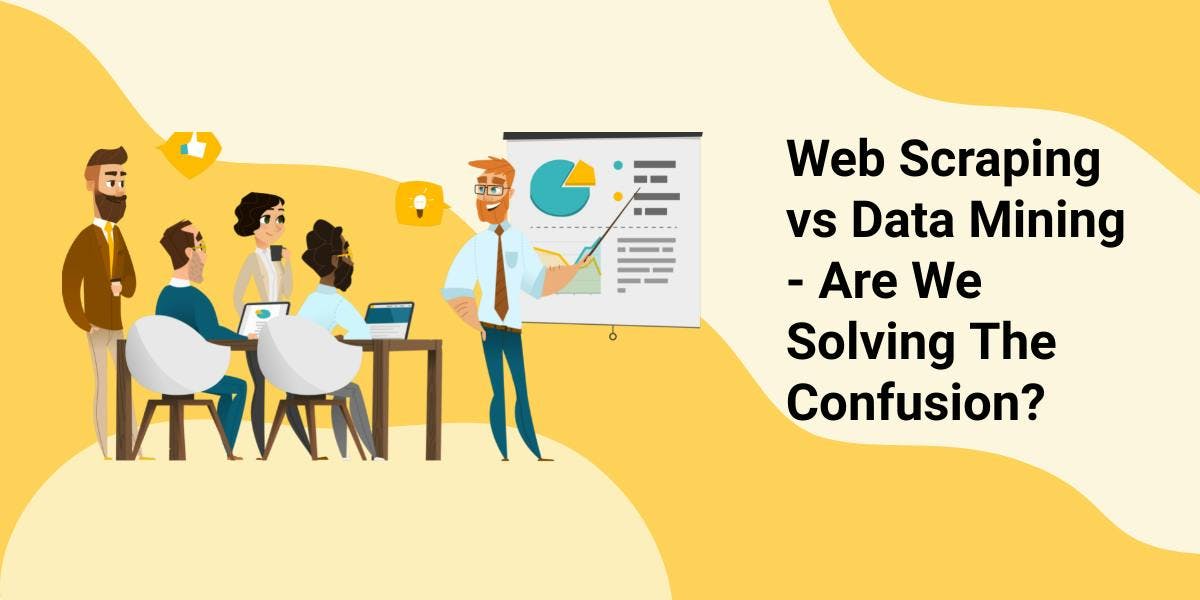Web Scraping vs Data Mining - Are We Solving The Confusion?
Ștefan Răcila on Apr 10 2023

Web Scraping vs Data Mining - Are We Solving The Confusion?
Web scraping and data mining are two techniques used to extract and analyze data from the web. Both methods have their own unique characteristics and applications. It's essential to understand the differences between them so you can start your career as a data analyst properly.
What is Data Mining?
Data mining is the process of discovering patterns and knowledge from large amounts of data. It is a multidisciplinary field that combines elements of computer science, statistics, and domain knowledge to extract useful information from data. Data mining can be applied to a variety of data sources.
For example:
- structured data in databases
- unstructured data in text and multimedia files
- data streams from sensors and social media.
Data mining is a solution for discovering trends, anomalies, and insights by transforming raw data into useful knowledge for businesses and individuals.
The term "data mining" can be misleading, as it implies that it is related to the extraction of data itself. However, that would be more in line with data scraping or web scraping. Actually, data mining is just a step in a process. The process takes already collected datasets and extracts valuable insights and knowledge from them.
How Does Data Mining Work?
There is no one-size-fits-all approach to data mining. Many data scientists follow a structured process when tackling business problems. This process can provide a clear framework to focus efforts and achieve desired results.
So data mining is a multistep process that involves several key steps, including:
- Data preprocessing. This step involves cleaning, integrating, and transforming the data to make it suitable for analysis. This can include tasks such as removing missing or duplicate data, handling outliers, and converting data into a format that can be easily analyzed.
- Data exploration. This step involves examining the data to identify patterns and relationships. This can include tasks such as creating visualizations to understand the distribution of the data, identifying correlations and dependencies, and detecting outliers.
- Data modeling. This step involves building models to represent the data and identify patterns and relationships. This can include tasks such as creating decision trees, clustering algorithms, and association rule mining.
- Data evaluation. This step involves evaluating the models to determine their accuracy and usefulness. This can include tasks such as cross-validation, testing the models on unseen data and comparing the performance of different models.
- Knowledge representation and discovery. This step involves representing the knowledge discovered in the data and communicating it to others. This can include tasks such as creating visualizations, summarizing the results, and creating reports.
It's important to note that these steps are not necessarily followed sequentially and some of them can be repeated. Additionally, the process can be iterative and may require going back to previous steps to improve the results.
Data Mining vs Web Scraping
While both web scraping and data mining are used to extract data from the web, there are some key differences between the two.
Web scraping is the process of automatically extracting data from websites. Data mining is the process of discovering patterns and knowledge from large amounts of data. They are not different solutions to the same problem. They complete each other. Web scraping provides data to data analysts. Data analysts do data mining on the provided data.
Web Scraping and Data Mining Use Cases
The ultimate goal of both web scraping and data mining is to use data to gain a business advantage or to solve a problem. Their applications are different. Web scraping is mainly used to collect data for use in new technical solutions. Data mining is more commonly associated with data science projects and business intelligence, rather than technical applications.
Some common use cases of web scraping include:
- Price comparison: Extracting product information and prices from e-commerce websites to compare prices and identify the best deals.
- Lead generation: Extracting contact information from websites to generate leads for sales and marketing.
- News monitoring: Extracting news articles from news websites to monitor mentions of specific keywords and topics.
- Social media monitoring: Extracting data from social media platforms to monitor mentions of specific keywords and topics.
- Search engine optimization: Extracting data from search engines to track search rankings, backlinks and other metrics.
- Job scraping: Extracting job postings from websites to gather information about job listings and salaries.
- Content scraping: Extracting text, images and other content from websites to repurpose for use in other websites, applications or analysis.
These are just a few examples of the many applications of web scraping. The possibilities are endless as long as the information is publicly available on the internet, web scraping can help you gather it.
Data mining has a wide range of applications in various fields including business, finance, healthcare, and government. Some common applications of data mining include:
Fraud detection: Identifying fraudulent transactions by analyzing patterns in financial data.
Customer segmentation: Identifying different groups of customers based on their characteristics and behaviors.
Marketing: Analyzing customer data to identify trends and patterns that can help businesses make better marketing decisions.
Healthcare: Analyzing patient data to identify patterns and trends that can help improve patient care and treatment.
Retail: Analyzing sales data to identify patterns and trends that can help businesses make better inventory and pricing decisions.
Inventory management: Analyzing inventory data to identify patterns and trends that can help businesses make better inventory management decisions.
Risk management: Analyzing financial data to identify patterns and trends that can help businesses make better risk management decisions.
Text mining: Extracting meaningful information from unstructured text data, such as customer reviews, news articles, and social media posts.
Predictive modeling: Using data mining techniques to build models that can predict future events or outcomes.
Network analysis: Identifying patterns and relationships in data from networks, such as social networks, transportation networks or communication networks.
Takeaway
Web scraping and data mining are two powerful techniques used to extract and analyze data from the web. While web scraping is typically used to extract structured data, data mining is used to extract unstructured data. Both techniques have a wide range of applications and can be used together to extract and analyze data from the web.
However, as scraping and mining large amounts of data can be complex and requires a lot of expertise and knowledge, it's better to use a professional scraper. They have the necessary experience, resources and expertise to handle large-scale scraping projects and provide accurate and reliable data.
Why don’t you try our professional scraper? You can sign up here and get a 14-days free trial to test our service.
News and updates
Stay up-to-date with the latest web scraping guides and news by subscribing to our newsletter.
We care about the protection of your data. Read our Privacy Policy.

Related articles

Dive into the transformative role of financial data in business decision-making. Understand traditional financial data and the emerging significance of alternative data.


Learn how to use Node.js and our API to scrape nearby sellers from Google Shopping. Extract valuable data quickly and easily with our professional web scraper.


Discover the step-by-step guide to web scraping Google Shopping product specs using Node.js. Improve your web scraping skills with this tutorial.
